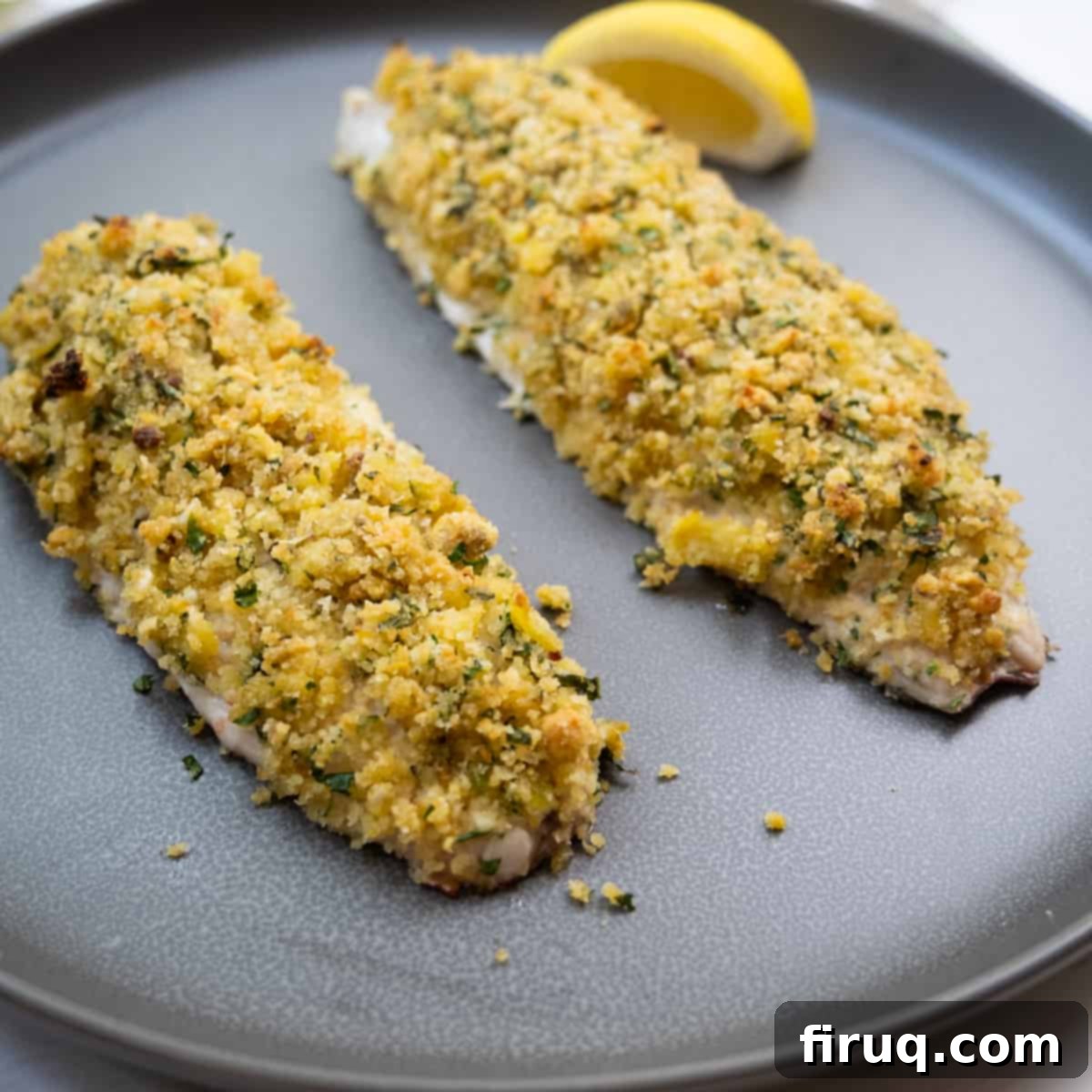Perfect Lemon Pistachio Crusted Snapper: Your Guide to Flaky, Flavorful Fish
Tired of dry, bland fish? It’s time to transform your seafood experience with this incredible Lemon Pistachio-Crusted Snapper recipe. Forget everything you thought you knew about cooking fish; this dish guarantees an incredibly juicy, tender fillet with a vibrant, nutty, and irresistibly crunchy crust. Each bite is an explosion of bright lemon, rich pistachio, and perfectly cooked snapper, making it a standout meal that’s surprisingly easy to achieve at home.
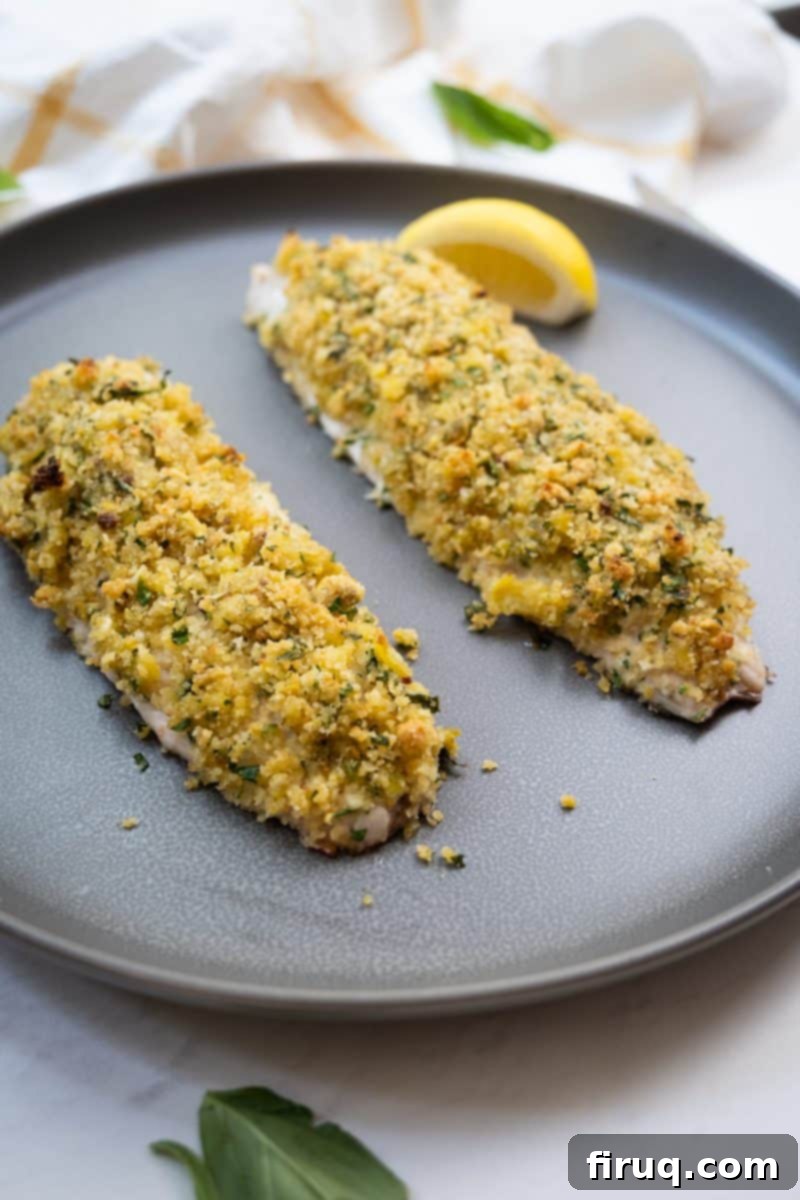
Craving more delicious seafood? Explore our other fantastic recipes, like the elegant Garlic Sage Seared Scallops, the crispy and flavorful Fried Flounder Oreganata, or the simple yet delightful Lemon Garlic Broiled Flounder.
This recipe isn’t just about cooking; it’s about elevating a simple ingredient into a gourmet experience. The secret lies in the carefully balanced flavors of the lemon-pistachio crust, which not only adds incredible taste but also locks in moisture, ensuring your snapper is tender and flaky every time. Whether you’re a seasoned chef or a home cook looking to impress, this dish is sure to become a cherished favorite.
[feast_advanced_jump_to]
Vermillion Snapper: The Star of Our Dish
For this outstanding recipe, we often turn to Vermillion snapper. This particular variety of snapper is celebrated for its wonderfully mild, subtly sweet flavor profile and delicate texture, making it an ideal choice for baking. Its firm flesh holds up beautifully to the baking process, ensuring it stays intact and moist. While they are generally a bit smaller than their red snapper cousins, Vermillion snapper delivers an equally, if not more, delightful culinary experience. It’s often my personal go-to fish for its consistent quality and delicious taste.
However, the key to any truly exceptional fish dish, including this one, begins with selecting the freshest possible seafood. Whenever you’re shopping for fish, prioritize freshness above all else. This recipe, like many seafood dishes, truly shines when prepared with freshly caught fish rather than pre-frozen fillets from the supermarket. I’ve experimented extensively with various methods to achieve the same consistency and flavor with frozen fish, but the results are rarely as satisfying. Frozen fillets, while convenient, often lose some of their natural moisture and can develop a slightly “wonky” or less desirable texture when cooked. Look for fish with clear, bright eyes, firm flesh, and a fresh, clean sea smell – never overly “fishy.” Trust me, the extra effort to source fresh fish will pay off immensely in the final taste and texture of your Lemon Pistachio Crusted Snapper.
Substitutions and Essential Ingredient Notes
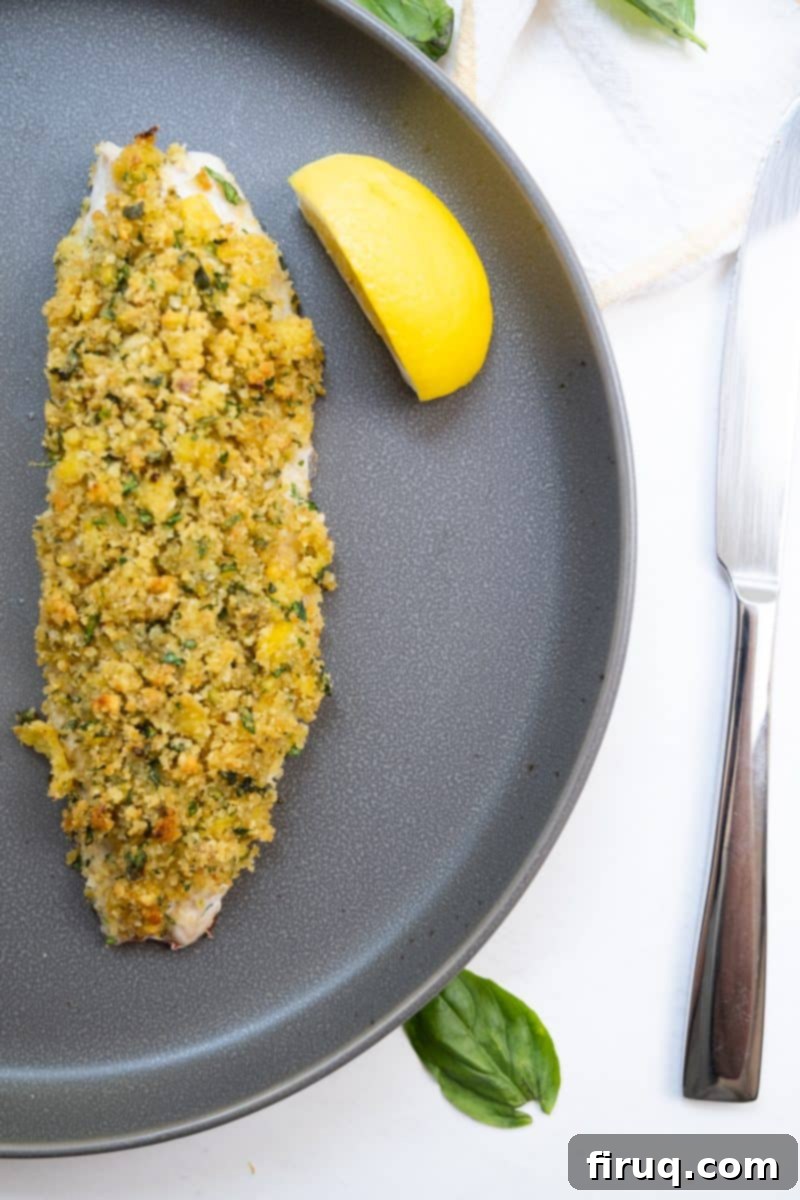
Snapper: While Vermillion snapper is our top recommendation, this recipe is highly versatile. Feel absolutely free to substitute with any type of snapper you prefer or can easily find. Other excellent white fish options that will work beautifully with this vibrant crust include flounder, tilefish, cod, or even sea bass. The key is to choose a firm, flaky white fish that can stand up to baking. An important step for an enjoyable eating experience, especially when serving guests or children, is to **debone the fish before baking it**. While many fish markets will do this for you, it makes a world of difference in ease of eating. If it’s just for yourself, you can handle it as you please, but for my wife and son, I always ensure the fillets are bone-free.
Lemon: The lemon plays a crucial role in both the flavor and the visual appeal of this dish. When you’re zesting the lemon, aim for only the bright yellow outer layer, meticulously trying to leave behind as much of the white pith as possible. The pith is inherently bitter and can impart an undesirable flavor to your dish. We’ll take an extra step to mitigate any potential bitterness by briefly boiling the zest. This process helps to mellow out the intense lemon oils and remove any remaining harsh notes, resulting in a beautifully bright and aromatic flavor that perfectly complements the pistachios and fish.
Pistachios: Beyond their delightful crunch, pistachios offer a rich, slightly sweet, and earthy flavor that pairs exquisitely with lemon and white fish. They add a sophisticated touch and a wonderful textural contrast to the tender snapper. For the best results, use unsalted, shelled pistachios.
Breadcrumbs: Good quality breadcrumbs are essential for forming that irresistible crispy crust. Panko breadcrumbs are an excellent choice here, as their larger, flakier texture tends to crisp up more effectively than traditional fine breadcrumbs, giving you an even more satisfying crunch.
Extra Virgin Olive Oil (EVOO): A good quality EVOO is not just a carrier for flavors but an ingredient in itself. Its fruity, peppery notes enhance the pesto mixture and contribute to the rich taste of the crust. Don’t skimp on quality here; it makes a difference.
Parmesan Cheese: Freshly grated Parmesan adds a salty, umami depth to the crust, helping to bind the ingredients and create a golden-brown finish. Avoid pre-grated varieties, which often contain anti-caking agents that can affect the texture and flavor.
Fresh Herbs (Parsley & Basil): These herbs provide a burst of freshness and aromatic complexity. Finely chopped, they integrate beautifully into the crust, offering subtle herbaceous notes that lift the entire dish.
Garlic: A staple in so many delicious recipes, garlic provides a foundational aromatic note that ties all the flavors together without overpowering the delicate fish.
Step-by-Step Directions for Flawless Snapper
This Lemon Pistachio-Crusted Snapper recipe might look gourmet, but it’s surprisingly straightforward. The most crucial aspect, which cannot be stressed enough when cooking fish, is to **cook for temperature, not solely for time.** This ensures perfect doneness every single time.
1. Zesting and Boiling the Lemon for Optimal Flavor
Begin by meticulously peeling the lemon using a sharp knife or a vegetable peeler. The goal is to obtain only the bright yellow zest, carefully avoiding the bitter white pith beneath. Once zested, fill your smallest saucepan with water and bring it to a rolling boil over high heat. Add the lemon zest to the boiling water and let it simmer for precisely 5 minutes. This quick blanching process is a chef’s trick to remove any residual bitterness from the pith and to mellow the intensity of the lemon oils, resulting in a cleaner, brighter lemon flavor in your crust. After 5 minutes, carefully remove the zest from the water and set it aside to cool completely. This cooling step is important to prevent it from “cooking” the other ingredients when mixed.
2. Crafting the Lemon Pistachio Pesto and Breadcrumb Mixture
Preheat your oven to a precise 425℉ (220℃). This high temperature is key to achieving a beautifully golden and crispy crust while the fish cooks quickly. In a food processor, combine the cooled lemon zest, shelled pistachios, fresh juice from half a lemon, two peeled garlic cloves, and approximately half of the extra virgin olive oil (EVOO). Process these ingredients until they begin to smooth out into a coarse pesto-like consistency, which typically takes about 30 seconds. Continue to slowly stream in the remaining olive oil while the processor is running until the mixture achieves a creamy, spreadable consistency. This ensures all flavors are well-incorporated and the texture is just right for coating. Next, add the grated Parmesan cheese and pulse a few times just until it’s combined. Over-processing the Parmesan can make the mixture oily. Transfer this aromatic lemon pistachio pesto into a medium-sized bowl. Add the breadcrumbs, chopped fresh parsley, and chopped fresh basil. Mix thoroughly until all ingredients are well combined. The mixture should feel moist enough that you can press it together to form a small patty, indicating it will adhere well to the fish. If it seems too dry, add a tiny bit more olive oil, one teaspoon at a time, until the desired consistency is reached.
3. Preparing and Baking the Snapper to Perfection
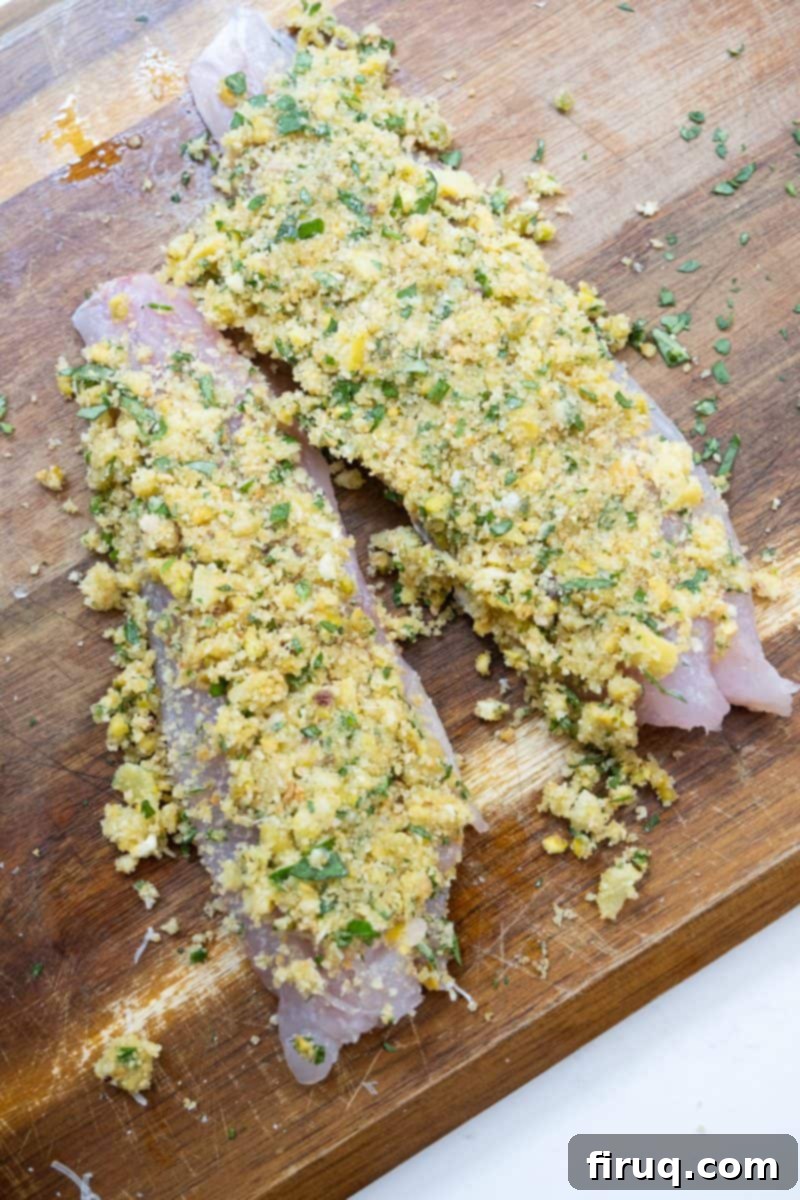
Line a baking sheet with parchment paper for easy cleanup and to prevent sticking. Place each snapper fillet, skin side down (if it has skin), onto the prepared baking sheet. Generously spoon the lemon pistachio breadcrumb mixture over the top of each fillet. Using the back of a spoon or your clean hands, gently **pat the mixture down** firmly onto the fish. This ensures a good, even coating that will form a beautiful, crispy crust. Transfer the baking sheet to your preheated 425℉ oven. Bake for approximately 5 to 9 minutes. This wide time range emphasizes the critical need to cook to temperature. The fish is perfectly cooked when it reaches an internal temperature of 145℉ (63℃) at its thickest point. Once cooked, remove from the oven and serve immediately. Garnish with an extra half a lemon for squeezing over the hot fish, enhancing its bright, fresh flavor.
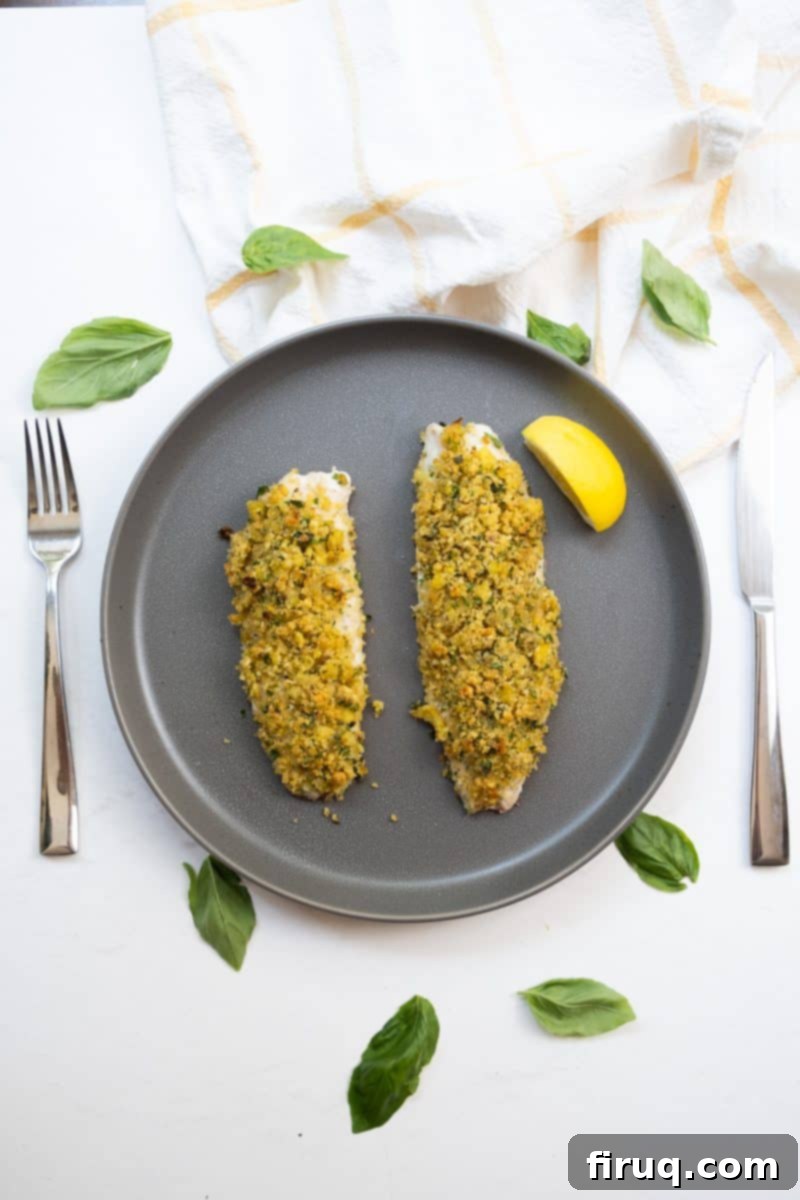
The Critical Importance of Temperature When Cooking Fish
Cooking fish can be a delicate dance. Fish fillets are extremely fragile, and if cooked even slightly incorrectly, the texture can become absolutely horrid – dry, rubbery, and utterly unappetizing. This is why I cannot stress enough how vital it is to use an instant-read thermometer when preparing fish. It is the single most important tool for achieving perfectly cooked, juicy fish every single time.
Let me illustrate with an example: I recently baked two snapper fillets that were almost identical in size and weight. One reached the ideal internal temperature of 145℉ (63℃) in just 5 minutes, while the other took a full 9 minutes. Imagine if I had simply followed a rigid time guideline and left the first fillet in the oven for the full 9 minutes! It would have easily exceeded 200℉, resulting in a completely overcooked, dry, and chalky piece of fish. Fish cooks incredibly fast, and the difference of just a minute or two can mean the difference between succulent and ruined.
An instant-read thermometer takes all the guesswork out of fish cookery. Simply insert it into the thickest part of the fillet, avoiding bones, and wait for the reading. For most fish, including snapper, the FDA-recommended internal temperature is 145℉ (63℃). At this temperature, the fish will be opaque throughout and flake easily with a fork, retaining all its natural moisture and delicate flavor. Invest in a good quality thermometer – it’s a small investment that will save countless meals from being overcooked and ensure your Lemon Pistachio Crusted Snapper is always a triumph!
What to Serve Lemon Pistachio Crusted Snapper With!
This vibrant Lemon Pistachio Crusted Snapper pairs beautifully with a variety of side dishes, enhancing its fresh, bright flavors. Here are some of our favorite combinations:
- Vegetable Sides:
- For a hearty and flavorful vegetable pairing, serve this alongside some Italian Cabbage or sweet and savory Maple Bacon Brussels Sprouts! These robust vegetable sides offer a delightful contrast to the delicate fish.
- Steamed asparagus or green beans with a drizzle of lemon and olive oil would also make for a light and healthy complement.
- A fresh, crisp garden salad with a simple vinaigrette can cut through the richness of the crust and balance the meal.
- Pasta & Grains:
- Pasta is another fantastic addition. Consider serving it with a light and bright Garlicky Cauliflower Pasta, a rich and smooth Creamy Red Pepper Pasta, or a zesty Lemon Pasta with Spinach!
- For a simpler grain, a delicate lemon-herb couscous or a light quinoa salad would soak up the flavors and add substance without being too heavy.
- Fluffy white rice or a classic rice pilaf would also serve as an excellent canvas for the flavorful fish.
- Soups:
- For a comforting and well-rounded meal, I’d definitely enjoy this with a hearty bowl of soup like the classic Zuppa Toscana or a warm and inviting Roasted Carrot Ginger Soup. The warmth and depth of a good soup can beautifully complement the crisp texture of the fish.
Frequently Asked Questions (FAQs)
To maintain freshness and flavor, store any leftover Lemon Pistachio Crusted Snapper in an airtight container immediately after it has cooled completely. Place it in the refrigerator, where it will keep for up to 2-3 days. When you’re ready to reheat, preheat your oven to 350℉ (175℃). Place the fish on a baking sheet and tent it loosely with aluminum foil to prevent the crust from burning and to help retain moisture. Reheat until the fish is warmed through, typically 10-15 minutes. For best results and food safety, use an instant-read thermometer to ensure the internal temperature reaches 145℉ (63℃).
While snapper typically has only a central line of small pin bones, removing them significantly enhances the eating experience, especially for children or guests. You can usually ask your fishmonger to debone the fillets for you when you purchase them, making your prep at home much easier. If you debone them yourself, run your fingers along the center of the fillet to locate any remaining bones and pull them out with tweezers or pliers.
While fresh fish is always highly recommended for the best texture and flavor, frozen fish can be used in a pinch. If using frozen fillets, ensure they are completely thawed in the refrigerator overnight or under cold running water before preparing. Pat them thoroughly dry with paper towels to remove excess moisture, as this helps the crust adhere and prevents a soggy result. Be aware that frozen fish may have a slightly different texture and may release more water during cooking compared to fresh, potentially affecting the crispness of the crust. Cooking time might also vary slightly, so always rely on an instant-read thermometer.
Yes, absolutely! You can prepare the lemon pistachio breadcrumb mixture up to a day in advance. Store it in an airtight container in the refrigerator. This can be a great time-saver when preparing for a dinner party or a busy weeknight meal. Just be sure to bring it to room temperature for about 15-20 minutes before applying it to the fish, as this makes it easier to work with.
A standard baking sheet lined with parchment paper is ideal for this recipe. The parchment paper prevents sticking and makes cleanup a breeze. If you don’t have parchment paper, you can lightly grease the baking sheet with olive oil, but the parchment paper provides a better non-stick surface, especially for delicate fish.
We truly hope you loved preparing and enjoying this exquisite Lemon Pistachio-Crusted Snapper. If this recipe brightened your day, please consider **leaving a rating below** on the recipe card! Your feedback is incredibly helpful and appreciated. For more culinary inspiration and delicious recipes, be sure to follow along on Instagram @vindelgiudice.
More Delightful Seafood Recipes to Explore!
- Lemon Garlic Broiled Flounder
- Pan-Seared Vermillion Snapper
- Cast Iron Lemon Dill Salmon
- Pistachio Crusted Fish
📖 Recipe
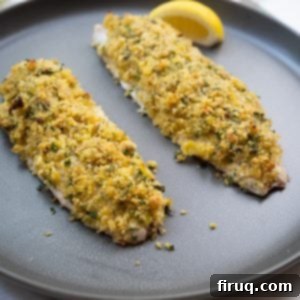
Lemon Pistachio Crusted Snapper
Vincent DelGiudice
Pin Recipe
15 minutes
15 minutes
30 minutes
Main Course
Italian
4
servings
466
kcal
Equipment
-
food processor
Ingredients
-
4
filets
vermillion snapper or similar fish -
¾
cup
breadcrumbs -
1
lemon, juice and rind -
½
cup
pistachios -
½
cup
extra virgin olive oil -
½
cup
parmesan -
1
teaspoon
salt -
2
tablespoon
chopped parsley -
2
tablespoon
chopped, basil -
2
cloves
garlic
Instructions
-
Start by peeling the lemon by zesting it with a sharp knife. Try to avoid getting as much of the pith as possible. Fill your smallest pot with water and bring to a boil. Add the zested lemons to the pot once it’s boiling. Boil for 5 minutes and remove. Set aside to cool.
-
Preheat oven to 425℉ (220℃). Add the cooled lemon zest, pistachios, juice from half a lemon, garlic cloves, and ½ the EVOO to a food processor. Process until it starts smoothing out, approximately 30 seconds. Slowly add more olive oil until it is creamy. Add the parmesan and pulse until combined. Pour bread crumbs, parsley, basil, and lemon pesto into a bowl and combine. Add extra olive oil if necessary to help combine; it should feel like you can make patties out of the breadcrumbs.
-
Top each snapper fillet, skin side down (if applicable), with the breadcrumb mixture. Pat it down firmly onto the fish to create an even crust. Bake the snapper for 5-9 minutes or until the fish reaches an internal temperature of 145℉ (63℃) at its thickest point. Serve immediately with half a lemon for squeezing.
Notes
- When baking fish, you need to use an instant-read thermometer to get the right temperature. Depending on the size and thickness of the fillet, 9 minutes can be entirely too long and easily overcook the fish, leading to a dry and rubbery texture. Always aim for an internal temperature of 145℉ (63℃).
- When zesting the lemon, be very careful to avoid the white pith directly under the yellow rind. The pith is very bitter and can negatively impact the delicate flavors of your dish. Stick to just the bright yellow outer layer for the best results.
Nutrition
Calories:
466
kcal
Carbohydrates:
22
g
Protein:
11
g
Fat:
38
g
Saturated Fat:
7
g
Polyunsaturated Fat:
5
g
Monounsaturated Fat:
25
g
Cholesterol:
9
mg
Sodium:
933
mg
Potassium:
268
mg
Fiber:
3
g
Sugar:
3
g
Vitamin A:
337
IU
Vitamin C:
18
mg
Calcium:
215
mg
Iron:
2
mg
Tried this recipe?
We’d love for you to Leave a Review!
